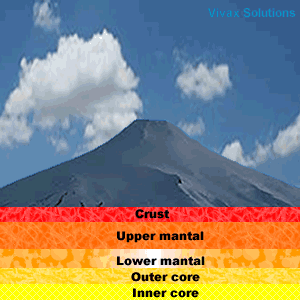Volcanoes Tutorial
Volcanoes and Earthquakes - it is Earth's fault!
Plate Tectonics
Perhaps it was not surprising
that scientists are not always on the same wave length all the time; the
‘Drifting Continents’ theory is a case in point.

People believed that features
like mountains, were formed when the Earth’s early crust shrank as it cooled
down. However, after Alfred Wagener's death, scientists started to notice
things that supported his theory. Once again, the death of a great man aroused
the enthusiasm of a subject which had been hotly debated.
The presence of same rock and
fossil features between other pairs of continents revitalized the debate of
once-being the same. Then explorers of the oceans discovered evidence that the
sea bed was spreading. In other words, continents were actually moving apart.
At last, people had to take the ideas of Alfred Wegener seriously. This says
that the Earth’s crust is made up from huge slabs of rock, called plates, and it
explain how they move?
The plates are still moving
today, although only a few centimetres a year, significant enough to take
matters seriously, when taking into account their sheer size. Volcanoes appear
where molten rock from beneath the crust rises to the surface through joints
between the plates.
Moving Plates
Nowadays, we can explain why
the plates move. It is pretty simple. Layer underneath the crust tell the tale.
It is the upper part of the mantle described earlier as ‘very thick
treacle’.
You can imagine the plates
almost floating on the mantle. The plates move because of huge forces caused by
convection currents in this partly molten rock.
We know that the deeper we go
into the mantle, the hotter it gets; Natural radioactive atoms are decaying
inside the Earth all the time. These nuclear reactions give out lots of energy.
They give out enough energy to melt rock and to set up the convection currents
that move the Earth’s plates.
Plates slipping past each other
Some plates are trying to slip
past each other. The most famous example of this is the San Andreas fault. It
runs down the west coast of the USA. It marks the boundary between the Pacific
plate and the North American plate. When the plates slip, there is an
earthquake.
As yet, we cannot predict
exactly when the plates will slip. So people in California have to live with
the threat of an earthquake at any time. Some says it is thirteen months
pregnant!
Plates moving towards each other
There are 2 types of material
forming the plates. In some places the plates are thin and dense. These are
found under the oceans (basaltic crust). Other plates are thicker and less
dense. These make up the continents' (granites crust).
In some places 2 plates are
moving towards each other. Where they meet, the denser oceanic crust slips
under the continental crust. This is called Subduction. The friction between
the plates can cause earthquakes. The rock can even get so hot that it melts
and rises to the surfaces to form volcanoes.
Finally, the whole oceanic part of the plate slips under the
continental crust. Then the two continental plates collide. The plates fold
upwards, forming mountains. Metamorphic rocks can form under this great
pressure. The Himalayas and the Alps were formed like this. Formation of them
is not a rocket science anymore.